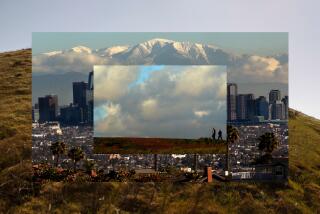Mountain Bicycling: It’s as Old as the Hills and Just as Hard : Off-Roaders Look Like Old 2-Wheelers
Bicycling in rough country on a fat-tired, multi-geared mountain bicycle can be a change of pace for those bored with working out in a floor-to-ceiling mirrored gym.
Roger Piper thinks so, and he’s been bicycling in the Santa Monica Mountains since the mid-1960s.
Piper once joined a gym but after a single visit decided that weight lifting and raquetball were dull. “I’d rather be riding in the hills even though it’s not as convenient and hardly as comfortable (as a gym).
“I like the solitude and the beauty of the surroundings. It’s interesting that you can be close enough to civilization to see the swimming pools and yet far enough out where, if you get in serious trouble, the ravens will find you before anyone else does.”
Upright Handlebars, Fat Tires
At first glance a mountain bike, with fat tires, upright handlebars and a frame made of oversized, thick-walled chrome molybdenum tubing, seems to resemble the old newspaper delivery boy two-wheeler of 30 years ago, before European-style racing bikes came into fashion. A racing bike is distinguished by drop handlebars, skinny tires and a frame of small-diameter tubing.
The large tires not only help absorb the jolts of the trail, Piper said, but also provide better traction than the smooth, skinny racing bike tires. To a mountain biker, obstacles like fallen logs, mud, streams and loose rock may not be discouraging, at least not enough to make him go back to riding regular roads, he said.
But riding in the mountains presents other problems.
On a recent evening, Piper strained to pedal uphill on a mountain trail peppered with rounded pebbles and small boulders. He was 10 feet from the top when he lost traction and began to slide back on the loose gravel and down the steep incline he had tried to conquer.
Piper got off the bike and hefted it onto his shoulder. “Sometimes you have to carry it the rest of the way,” he said as he walked to the top of the trail.
Hanging In There
“The better riders are going to be the last ones to get off the bike and walk,” he said. “There are many places where you’ll make better progress if you throw the bike over your shoulder and carry it, but jumping from boulder to boulder is not mountain biking.”
Piper rides in Rustic Canyon, Sullivan Canyon, on stretches of the Backbone Trail and in other areas. He likes the unexpected in mountain bicycling. “A trail that you rode two weeks ago is unridable because of a slide or a downed tree. It’s interesting because the geography (of the mountain trails) changes so fast.”
He also likes the technical challenge. “If the handlebars are too wide (and you are riding the dry stream bed at the bottom of Rustic Canyon), the willows will grab the bikes’s handlebars and throw you to the ground,” said Piper, who designs and builds customized mountain bikes at his Santa Monica bike shop. He recommends that the bars be no wider than 20 inches across.
Mountain biking has been around almost as long as bicycles, said the 35-year-old Piper, a Venice resident. During the early 1900s British bicyclists referred to off-road biking in mountainous terrain as “rough-riding.”
10-15 Gears
But the mountain bike’s new popularity and modern design originated in California, according to Glenn Odell, president of the National Off-Road Bicycle Assn. (NORBA).
Like a racing bike, the mountain bike is equipped with 10 to 15 gears. (The number of gears depends on the manufacturer’s design or on a rider’s preference if the bike is built to order.) But the mountain bike, with a smaller chain wheel and larger sprockets on the rear hub, has lower gears than a racing bike to ease the strain of pedaling up steep grades.
Since 1982, when fewer than 5,000 mountain bikes were bought in the U. S., Odell said, sales climbed to 225,000 last year. Bicycle manufacturers have projected sales of 460,000 this year. A spokesman for the Bicycle Federation, a national organization that promotes recreational bicycling, estimated that sales of off-road bikes should increase this year by 100% over 1984.
Piper said many customers are looking for a macho image when they buy an all-terrain bike for about $700. “They’ve read some magazine article called ‘I RodeMt. Kilimanjaro on My Mountain Bike’ and suddenly they want one,” he said.
Few Ride Mountains
Locally, many are buying mountain bikes, but few ride the mountains. That’s how it appears to people who run bicycle shops and to park rangers in the Santa Monica Mountains.
Where are the bikes if they’re not in the mountains? “The vast majority are riding them on the street,” said Steve Aldridge, who runs a Marina del Rey bike shop. “It’s the macho image--like people (who live in the city) who own four-wheel drive Jeeps. The bike is a cheap off-road vehicle, but most of these people will never be going off-road. It’s a comfortable street bike, an upgraded cruiser, for people who have been scared off 10-speed racers.”
Local bicycle shop managers agree that mountain bike sales have gone up since the bike began to be mass-produced about three years ago. Greg Stokell, who manages a Santa Monica bicycle shop, said, “From nowhere, three years ago, the demand for the bike has been getting stronger and stronger.”
Stokell said mountain bike sales had been erratic in 1983 and 1984, but demand in the first five months of 1985 has been high and consistent.
‘A Big Thing’
Both Aldridge and Eric Gottesfeld, manager of a West Los Angeles shop, said sales are on the increase. Robert Kueker, who runs a Culver City bike store, said, “It’s getting to be a big thing.”
Though the bikes may sell well, Mikal Sandoval, a ranger at Will Rogers State Park, estimated that on an average Saturday or Sunday, the park’s busiest days, fewer than a dozen mountain bikers could be found riding the trails. “We rarely see anyone mountain-biking up in the canyons, (but) recently, we’ve begun to see more of them on the fire roads.”
But Piper estimated that there are 40 to 50 people who regularly bicycle in the Santa Monica Mountains. “We rarely see any rangers,” he said.
On the more prevalent use of mountain bikes as street bikes, Odell said, “Happily, everyone isn’t taking to the mountains or we’d be having a worse problem.”
The problem that the president of NORBA, a 1,500-member off-road biking club, is worried about is the persistent complaint from hikers, equestrians and the Sierra Club about mountain bikers barreling downhill, risking collision with a hiker or a horse rider.
No Incidents Cited
But neither Topanga State Park Ranger Chris Goodfellow nor Ranger Sandoval could cite any incidents of a collision between a bicyclist and a hiker or a horse rider.
Jill Swift, chairman of the Sierra Club’s Santa Monica Mountains Task Force, said her committee had heard complaints from hikers about mountain bicyclists in the Temescal Canyon area of Topanga State Park but had not heard of recent problems.
“Unless it becomes a serious problem, we have no intention of making a policy to cover mountain biking (in the Santa Monica Mountains),” she said.
The rangers said that while the parks have no specific policies concerning mountain bikes, all vehicles are restricted to a speed limit of 15 miles an hour in the parklands of the Santa Monica Mountains. That speed is easily surpassed on the steeper grades, said Oliver Grosz, an experienced mountain biker who lives in West Los Angeles.
Grosz agreed that stopping the bike on a steep incline is a problem. Since riding on the loose rock surface is akin to “riding on marbles,” even the best riders risk crashing on a downhill run, Grosz said. “If you brake without sliding the rear tire forward, you’ll go right over the handlebars. The only way to stop on a steep trail is to squeeze the (hand) brakes as you slide the bike.”
Efforts to Ban Them
Even if most mountain bike owners aren’t riding on mountain trails, the Sierra Club is taking no chances, said Sally Reed, a national director of the club. She said the Sierra Club recently rewrote its national policy to include mountain bikes in its definition of off-road vehicles prohibited from designated wilderness areas. Before the revision the Sierra Club defined off-road vehicles as “any mechanized mode of transport” such as four-wheel-drive vehicles, dune buggies or motorcycles.
Federal laws bar “mechanical transport” in designated wilderness areas, and the National Forest Service and the National Park Service barred mountain bikes from many other wilderness trails.
But Odell cites the Code of Federal Regulations, which defines “mechanical transport” as any device “propelled by a non-living power source.”
“There’s no motor on a mountain bike,” Odell said. “It still takes foot power to get to the top of a hill.”
Reed Disagrees
Reed, who pushed for the inclusion of mountain bikes in the off-road vehicle category, disagrees with Odell. “A bicycle is mechanized,” she said. “It has a mechanical advantage.”
“I wouldn’t mind having a mountain bike--might be a fun thing to do,” she said. “But I wouldn’t ride it in areas where it would be an intrusion on other people or in environmentally sensitive areas.”
On riding in the Santa Monica Mountains, Piper said, “Most of the places we ride are practically roads. We’re not barging through any freshly sprouted virgin meadows.”
At the state and city park level, Reed said, the Sierra Club wants local park management to designate areas within the parks for off-road vehicles and to limit mountain biking to those areas.
She said that she sees no reason why mountain bicyclists should be banned from fire roads or fire trails but that she is concerned about trails that are only 15 to 18 inches wide. “It’s obvious that a group of 10 bicyclists is an absolute hazard on that kind of trail.”
Problem Therapy
Joe Edmiston, executive director of the Santa Monica Mountains Conservancy, echoed her concern. “We don’t think mountain bikes should be used on the narrower trails.”
But, he said, the conservancy this year has donated $20,000 toward a Hollywood YMCA mountain-biking program for “problem-case kids who need to work out all that excess energy.” Piper said that before a novice takes a mountain bike on a mountain fire road, he should try the Inspiration Point Trail at Will Rogers State Park “so he can get the feel of what it is like to ride on dirt.”
Piper and park rangers also advise that riders obtain topographical maps of areas they intend to explore. Other tips:
- Bring at least two quarts of water, because stream water may be contaminated. Never bike alone. Return before dark.
- Be wary of rattlesnakes, particularly when dismounted. “I don’t know how dangerous a rattlesnake would be to a mountain biker riding by,” Ranger Sandoval said. “Most people get bitten because they picked a snake up.”
Among the more popular trails in the Santa Monica Mountains are Fire Road 26 above Sullivan Canyon and the Temescal Fire Road between Mulholland Highway and the Palisades Highlands. As for other trails, Piper said, “At the top of almost any canyon you pick, there’s a fire road that’s ridable.”
More to Read
Sign up for The Wild
We’ll help you find the best places to hike, bike and run, as well as the perfect silent spots for meditation and yoga.
You may occasionally receive promotional content from the Los Angeles Times.






